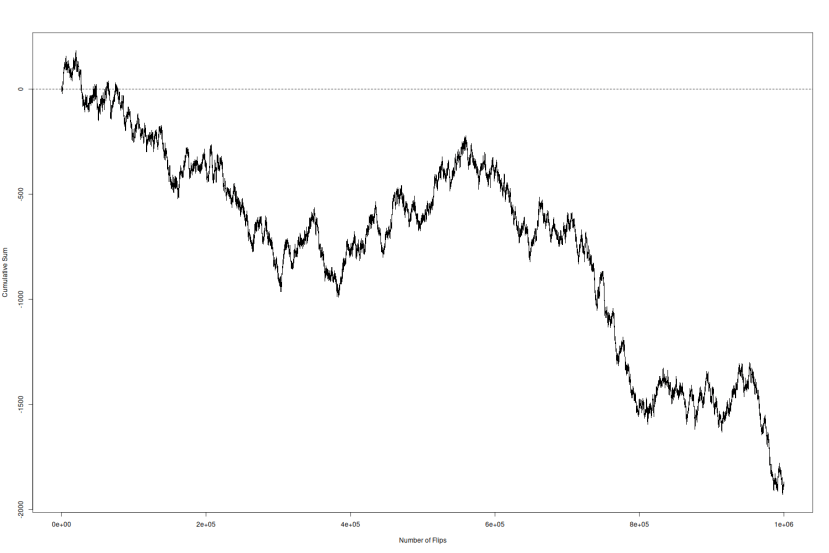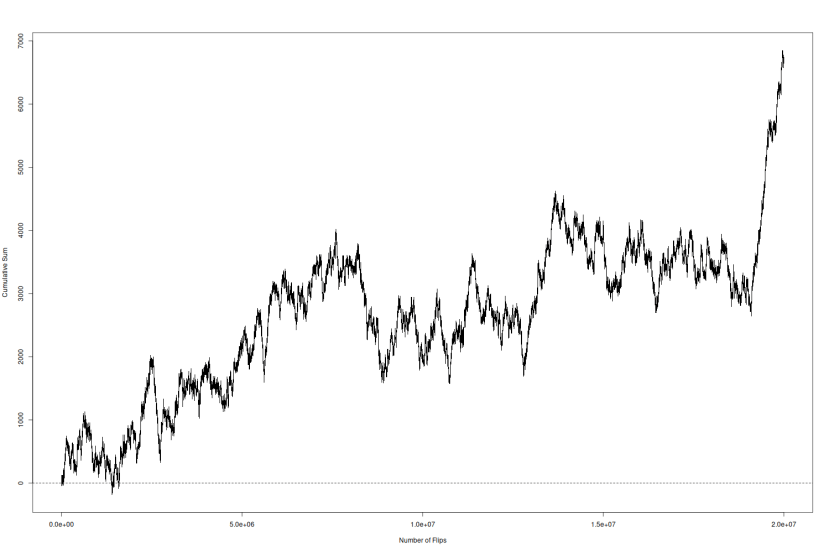My friends, the title is not hyperbole. The scheme I present below will work. But it will require some hard work to get there. Which is only proper, since we are talking Nobel prize. Stick with it.
So these guys, vaguely attached to Princeton, hooked up certain machines to about five dozen “eggs” (computers) around the world, and they have these things, even as you read this, churning away producing “random” -1s and +1s. (They use diodes near their breakdown voltages and filter the output. Thanks to Anon for the tip.)
They keep track of the running sum of these numbers, which stop and start up at various times. About which more below.
They do this curious thing because they figure large psychic bursts, as it were, are caused by people all over the word when remarkable things happen. And that these bursts, which are part of the “Global Consciousness”, can be seen in the voltage generator outputs (the -1s and +1s). Here’s a paper on the process (pdf).
Now materialists, those who believe all there is atoms bumping into each other, will scoff at this and dismiss it out of hand.
Bad attitude, because materialism is false. Our intellects and wills (how we all miss YOS!) are not material. The First Cause is outside space and time, if you like, as Wolfgang Smith and others have taught us. There is no a priori reason why minds separated by large distances could not communicate with each other.
Somebody should write a book on this, at the entry level, and give it away free.
Our Princeton-lite crew claim they see a “statistically significant” signal in the -1s and +1s after the Derek Chauvin murder trial verdict was announced. Attention ladies: wee P-values will be flashed!
The death of George Floyd became an international focus, and the trial of his killer was a culmination in the sense that tremendous attention and emotional concern attended the trial. We set a quasi-formal analysis for the period beginning with the announcement of the guilty verdict, which generated celebrations and relief for large numbers giving this tragedy their attention.
Here’s a screenshot of their evidence, where we see “Z scores” instead of sums, but it’s the same thing, and done only to get easy P-values.
I’ll explain these plots, I hope gently, in a moment.
I believe they are fooling themselves for two reasons, neither of which have to do with materialism. And one of which will benefit you.
The first is obvious. Why would a handful of minds focusing on a small trial interact with those eggs? And how? It makes no sense. As a repairer of electronics I can tell you I myself have unleashed mega-gigaton-bursts of psychic energy, lathered with a creative patois I learned in the military, when the damned machines I’m attempting to fix remain recalcitrant. I have never seen these bursts influence anything except those forced to live with me.
So the supposed mechanism of the Princeton-lite guys is not plausible. Not that this is proof that such a mechanism doesn’t exist, but it’s good evidence.
The second reason is the real point of this article. I’m going to teach you how you can win a Nobel Prize using “randomness.”
Think you know “randomness”?
You flip an object, like Princeton-lite, a lot of times, with sides “-1” and “+1”. You keep a cumulative sum of the flips, starting at 0. If your first two flips are “+1” and “-1”, then the cumulative sum is 0. And so on.
So that there is no angst or unnecessary distraction about “fairness”, I guarantee, through my eminence as the Statistician to the Stars!, the probability of each outcome is 1/2.
With me?
Flip your device a lot of times. Make it a big number. Go wild.
What do you expect the cumulative sum will be? I’m not asking you to nail it precisely. Approximately will do.
Did you say 0?
That’s wrong. Boy, howdy, is it wrong.
But wait. There is a mathematical definition of “expected”, and if you used that, then the answer is indeed 0.
Yet I didn’t mean “expected” in some arcane mathematical sense that only a few people understand. I meant the plain-English idea of the actual number we’d see. We don’t and can’t always see “mathematically expected” numbers—the “mathematical expectation” of a die throw is 3.5, which you will never see on any toss.
Here is an example of the cumulative sum of a million flips I generated (I’ll paste the code below so you can win your Nobel):
Another (and the very next one):
Try it yourself. It’s possible to get a 0 (the ending sum) in these “trials”, but it isn’t likely.
The first sum after a million flips was about -2000, and the second about 380. That’s a mean of (-2000+380)/2 = -810. If we did these plots a huge number of times and took the mean of all the sums, that mean would go to 0, as “expected”.
But who cares? We aren’t looking at averages of experiments, we’re looking at these two experiments, like the Princeton-lite guys and their experiments. Or any scientist and his. This is key.
It makes some sense to think individual sums should be around 0; after all, you’re adding numbers that cancel out other numbers, each about half the time. So that if we saw a large departure from 0, we might seek for explanations other than “randomness”, explanations like psychic bursts. Or, maybe, dark energy. Hold that thought.
Why does this happen? The details are too much for us, but these cumulative sum series are modeled by something called an arcsine law. Here’s a review of an old paper which suggested global warming could be explained by such results.
These sequences have a fascinating property. If you stare at the plots you can see little waves of growth, followed by negative waves. These waves never stop growing. The distance from 0 and the distance from positive peak to positive peak grows and grows without limit. They are self-building waves. Again, do try this yourself. Here’s one with 20 million flips. I got that after 4 tries, the others being less impressive, but still impressive enough to wow those wily Swedes.
There’s nothing special about the million, except that it (I think) comes close to size of files the eggs are spitting out. Try it at 100, or whatever, though of course the larger the number you try, the more likely large departures become, as you see.
The eggs used unpredictable voltages. I used a computer’s pseudo-random number generator, which are perfectly predictable: the algorithm that spits them out is known. You, in your pursuit of the Nobel, can use anything you like. All they have to be are numbers.
The trick comes in seeing you can get the same results regardless whether the numbers are unpredictable or predictable. And by recalling that “random” means “unknown cause”. And by the magic of moving from “unknown cause” to wrongly ascribed cause. Via wee Ps.
Think of it this way. The Princeton-lite people could have ascribed the cause of the large sums they observed to anything. Subluxations of the spine. Dark energy. Tunneling neurons. Strings escaping the multiverse. Climate change. Whatever your fervid imagination can invent. It didn’t have to be psychic energy. They just said it was.
You can start your own eggs going and instead of counting voltages you count dark energy emanations, or how they effect cosmic rays hitting the earth, using some fancy equipment you’ve carefully designed in accordance with your theory. If not dark energy, then brane (not brain) vibrations. Whatever you like.
The -1 and +1 make the math easy, but they’re not strictly necessary. It’s the accumulation that does all the work for you. And the notion that mathematically “expected values” are what you’d expect to see.
That and wee Ps. Which I won’t show you how to calculate, as this would be like Dr Van Helsing teaching you how to suck blood.
That’s it. You have everything you need. It works. And has worked. It will work for you. To make your efforts Nobel worthy, you only need make your causal attribution sound plausible. You need not prove it. Because if you could, you wouldn’t need these tricks. Bursts of psychic energy are no longer plausible—though it does seem we are doomed to relive the 1970s, so this may become a popular explanation again.
Look. The idea is simplicity itself. It’s done every time a “hypothesis test”, frequentist or Bayesian, is done.
Step one: Propose the false dichotomy “Either randomness caused these results, or my favorite explanation did.” Don’t worry about being called out on this. Everybody buys it.
Step two: Get a wee P (or large Bayes factor), declare the randomness hypothesis false, and the insist your favorite explanation is true. You will be believed. It’s easiest to get wee Ps when -1/+1 trick, but mixups between plain-English expected results and mathematical expectation abound. There’s plenty of ways to get this to work.
All the real magic is in the false dichotomy, but it’s made a whole lot easier by the the Deadly Sin of Reification, mistaking the model’s expectation with reality.
The great freedom of the false dichotomy, is that any—absolutely any—causal explanation can be put forward as the alternate of “randomness”. And your audience has to buy it.
There you are. That’s how modern Science is done. Use this tool wisely. And when you win, invite me to the ceremony.
Subscribe or donate to support this site and its wholly independent host using credit card click here. Or use the paid subscription at Substack. Cash App: $WilliamMBriggs. For Zelle, use my email: matt@wmbriggs.com, and please include yours so I know who to thank.
The Code
n = 1e6
x = cumsum(sample(c(-1,1),n,replace=TRUE))
plot(1:n,x,pch='.', xlab='Number of Flips',ylab='Cumulative Sum')
abline(h=0,lty=2)








I see a cynical ploy to milk what some (no, not me of course!) say is a manufactured narrative and completely artificial sequence of highly visible events. By “discovering” the “impact” thereof, they demonstrate their woke bona fides and thus their worthiness to receive a reliable stream of donor/taxpayer money.
They believe it no more than they believe in the tooth fairy.
On an unrelated note, a fox killed 11 of my chickens the other night. The release of psychic energy caused my internet to go down. What else could it have been that but that?
I like what I don’t totally understand sometimes. But any time I read an article poking fun at the Nobel committee, I’m game.